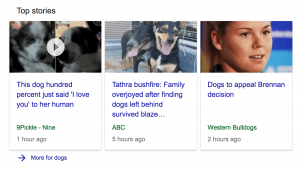Sometimes the hardest part of understanding a new concept is the terminology. There are a substantial amount of SEO terms in the online marketing sphere, and we will keep adding to this glossary page as more important SEO terms develop.
What is…
What is CMS?
Content Management Systems (CMS) are applications, software and programs used to design, generate and manage digital content. This digital content can include maps, graphics, photos, text, and program codes to engage with the consumer. An advantage of Content Management Systems is the SEO friendly URL’s, allowing the search engine algorithms to read the page effectively. WordPress is an example of a CMS platform.
What is NAP?
Name, address, phone number (NAP) is essential for businesses wishing to place higher in organic search listings within their geographic area. This is particularly important for local businesses, since search engines take into account the physical location of the person conducting the search. It is important that a business’s details are up to date online, and that there are no disparities between them.
What is SERP?
Search Engine Results Page (SERP) is the page displayed by a search engine such as Google, once a search has been conducted. These results are either organic, i.e. retrieved by the algorithm or through sponsored advertisements.
What is CRM?
Customer Relationship Management (CRM) is the process of maintaining and creating relationships between business and clients, through interaction.
SEO Terms / Glossary
Stop Words
Online search engines have been set to ignore certain words when searching and retrieving responses for questions. These ignored words are ‘stop words’, and comprise commonly used words such as ‘the’, ‘and’, and ‘is’ etc.
Outreach
The purpose of outreach is to develop valuable backlinks from external websites to your website. These backlinks improve the organic ranking of a companies’ website, and therefore allow new audiences to view content.
Featured Snippets
Featured snippets are selected search results that feature at the top of an organic Google search. Googles’ algorithm deems these snippets to be the most valuable. Featured Snippets are also the responses that voice search platforms such as “Siri” use for answers.
Schema Markup
Schema is a type of code you put in your website, designed to help a search engine return more informed response. Some examples of Scheme include: product review stars that often appear next to a search.
Another form of Schema is the news articles that appear in search results, for example “Dogs” returns this as the top responses:
Google Algorithms
Google Panda
Google Panda is an update to Googles’ algorithm, introduced in 2011 . It aimed to decrease the ranking of low quality websites with limited content, and increase ranking of high quality sites. The change affected 12% of all search results.
Google Penguin
Google Penguin is the nickname given to a Google algorithm introduced in 2012. This algorithm aims to decrease the search engine rankings of websites that do not meet Google Webmasters Guidelines. An example of violating these guidelines is manipulating a number of links to direct to your page.
Google Hummingbird
Google Hummingbird is the name given to another Google algorithm introduced in 2013. Hummingbird places a great emphasis on natural feeling queries and takes into account the contexts of queries to return a more accurate result to the searcher.
One excellent example of Hummingbird in action is written by Dan Shewan from WordStream article ‘How Google Hummingbird Changed the Future of Search’.
“if a user performs a search for the term “weather”, it’s much more likely that they are looking for a forecast for their area, not an explanation of the science or history of meteorology.
-
“Weather” is the subject of the search
-
The desire for a local forecast is the user’s intent
-
The difference between a weather forecast and an explanation of meteorological concepts is the context”
Conversion
A conversion is the name associated with a user fulfilling a site goal. This could be purchasing a product or signing up to an email list.
Robots.txt
Robots.txt is the robots exclusion protocol. This tells web robots which areas of websites should be scanned and processed, however sometimes the robots think they know better as a result, still allow the site to be scanned and processed.
nofollow
No follow is a HTML value that tells the internet bots to ignore a link as a ranking factor when delivering a search engine results page. e.g. <a href=”http://www.google.com” rel=”nofollow”> tells the bots not to count the link when ranking pages.
HTML Status Codes
404 Error
A 404 error tells a user that the server was able to process their request but could not find what was asked. This will commonly appear when clicking on a dead or broken link.
301 redirect
A 301 redirect, redirects users and search engines to a different URL page from the one initially requested. 301 Redirects are permanent and transfer 99% of ranking power to the new page that has been redirected too.
rel=canonical
rel=canonical is an HTML element that prevents multiple pages of the same content by clarifying and specifying which page is the preferred version. Yoasts’ post gives a great example of using rel=canonical.
Media Buying
Lead Generation
Lead Generation is the process of generating interest in a brand or product. This can be done in a number of ways, for example, email, content marketing and events.
Brand Awareness
The extent to which customers are able to easily recall a brand. Types of brand awareness include brand recall and brand recognition. Brand recall is unaided and spontaneous, with brand recall a consumer should be able to immediately name the brand when [resented with a category. Brand Recognition however is a form of aided recall. This means a consumer can’t remember the brand name, but when presented with the items in their packaging, will recognise the brand they know.
Goal Completion in Analytics
Goals measure how well your site or app fulfils your target objectives. A goal represents a completed activity, called a conversion, that contributes to the success of your business.
Conversion Actions in Adwords
A conversion action is a specific customer action that you’ve defined as valuable to your business. This could be things like signing up to an email list, making a purchase, or phoning the business.
Low Touch
Low touch marketing has very limited human interaction. A low touch marketing method could be sending out an email blast, which is very impersonal. Low touch marketing simply wants a quick sale, rather than the personal customer relationship.
EDM
EDM stands for Electronic Direct Mail. EDM isis used to target a large group of prospects or clients, and is focused on building (customer) relationships and generating leads. It is excellent for fostering rapport, increasing brand awareness and keeping customers up to date.
Remarketing Advertising
Remarketing is an online strategy designed to redirect customers back to a webpage. For example, if you go onto Kmarts webpage and browse at some products, you may notice later on when looking at other web pages, that Kmart ad’s are appearing. These are trying to redirect you back to Kmarts page to make a purchase.








